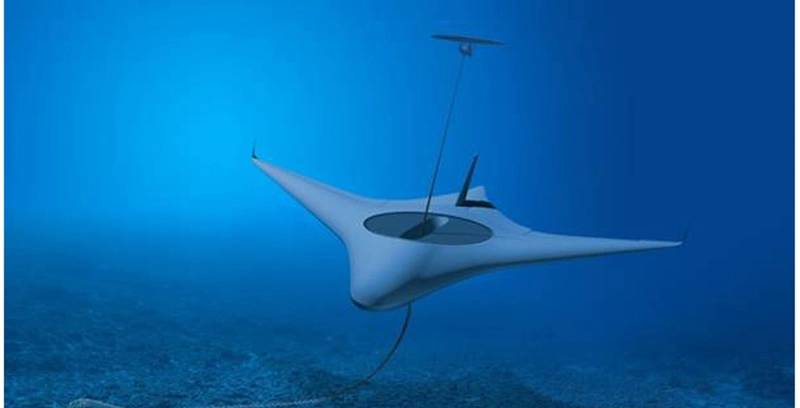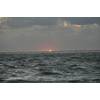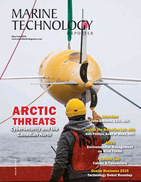Back to the Future: Blended Wing Gliders Could Redefine Undersea Warfare
Since it was first proposed by Henry Stommel in a 1989Oceanography magazine article, the underwater glider has become a mainstay of ocean scientific research. The Teledyne Marine Slocum glider(named for Joshua Slocum, the first to solo circumnavigate the globe in a sailboat),along with its cousins the Kongsberg SeaGlider, originally developed by the University of Washington, and Spray Glider, jointly developed by Woods Hole and Scripps Institute of Oceanography, have been at the forefront of the marine robotics revolution. Gliders are unique among autonomous underwater vehicles (AUVs). Rather than use thrusters or propellers for propulsion, they rely on changes in buoyancy, in combination with wings and stabilizers, to "fly" through the water column in an up-and-down, sawtooth fashion, periodically surfacing to communicate with human operators ("pilots"). Although battery-powered, gliders consume less energy than AUVs using conventional propulsion, leaving more to power onboard sensors, C2, and communication systems. They are inexpensive, deep diving (anywhere from a few hundred to several thousand meters), capable of accommodating a range of sophisticated sensors, and can remain in situ for weeks, months, or even years, enabling persistent observation and collection of a wide range of hydrographic data.
These capabilities, as well as their inherent stealthiness, also make them ideal for defense applications. The United States Navy, for example, currently operates a fleet of Slocum gliders - Littoral Battlespace Sensing Gliders (LBS-Gs) - which are used for anti-submarine warfare (ASW) and intelligence preparation of the operational environment (IPOE).Like their scientific counterparts, LBS-Gs also collect hydrographic data, but for purposes of optimizing undersea warfare operations. Properties such as depth, temperature, pressure, and salinity dictate how sound travels through water, which in turn impacts the ability of acoustic sensor systems to detect and track underwater targets.
But as cheap, versatile, and energy efficient as they are, gliders are optimized for smaller, lightweight sensors focused primarily on hydrographic and oceanographic measurements. They are also quite slow, averaging anywhere from one half to one knot per hour, and can be easily influenced by underwater currents. And they lack the capacity to carry larger, heavier payloads such as hydrophone arrays, additional batteries for extended range, expanded onboard processing, or even sea mines or heavyweight warheads. How might this platform be re-engineered to overcome these limitations and enable a broader range of missions?
Enter the blended wing underwater glider.
In the early 2000s, the Office of Naval Research, in partnership with Scripps Oceanographic Institute, Woods Hole, SAIC, Bluefin Robotics, and the applied research labs of Penn State and the University of Texas, Austin, sought to develop a high-endurance underwater glider capable of accommodating large payloads for use in marine mammal observation or ASW hold-at-risk operations. The result was the Liberdade-class blended wing underwater glider, an underwater vehicle that resembled a stealth bomber more than an AUV. Two variants were constructed–the XRay and its more capable successor, the ZRay. With a hydrodynamically efficient hull, and a lift to drag ratio of 35-to-1, the ZRaywas reportedly capable of carrying payloads of 800kg, reaching speeds of five knots, and conducting sustained operations for up to six months.
Little has been published regarding the ZRay, and other than scattered mentions in scientific publications, it has all but disappeared. There are references to its potential role in U.S. Navy PLUSNets (Persistent Littoral Underwater Surveillance Networks) - autonomous, undersea ASW networks comprised of fixed seabed sensors and AUVs, and deployed in coastal regions to track adversary diesel-electric submarines. DARPA's current Manta Ray program, a blended wing test platform for developing "a new class of long duration, long range, payload-capable UUVs" may be a reconstitution, or simply a beneficiary, of Liberdade research. Alternatively, U.S. research efforts may have "gone black" and formed the basis for classified research and development.
Whatever the fate of the ZRay, interest in blended wing gliders continues, and has not been limited to the United States. In 2020, Australian marine engineering company Ron Allum Deepsea Services unveiled Deep Ray, a vehicle developed under a contract with Australia's Defenze Science and Technology Group (DST). Japan, Germany, India, South Korea, and the People’s Republic of China have all conducted independent scientific research on this type of vehicle. Chinese scientists have demonstrated a keen interest in blended wing gliders, having published over forty papers on the subject since 2013. Given China’s long-standing interest in conventional gliders for scientific research, this should come as no surprise. Chinese scientists have experimented with conventional gliders for many years, achieving several high-profile records for both depth and endurance. They have been deployed to both the South China Sea and Indian Ocean, with some washing up on the shores of the Indonesian archipelago, and given the dual-use nature of hydrographic data, China, like the United States, is surely deploying gliders not only for purposes of scientific research, but ASW as well. To that end, Chinese researchers have explored using conventional gliders as acoustic sensor nodes by equipping them with one or two single vector hydrophones. With a quiet, payload-capable blended wing glider, however, a full array of hydrophones could be positioned along the vehicle’s leading edge, making it a highly capable ASW platform. And if they were deployed in large numbers, or alongside seabed sensors and other autonomous vehicles as with PLUSNets, they could pose a serious dilemma for opposing submarines seeking to operate along the first or second island chains, or beyond.
With the increasing proliferation of submarines, including large displacement and extra-large autonomous underwater vehicles (XL-AUVs), there will be an increasing demand for persistent, integrated, wide-area surveillance of the ocean depths. Given their impressive performance characteristics – high speed, high endurance, heavyweight payload capacity - blended wing underwater gliders are well suited to this role. And as navies worldwide double down on investments in undersea warfare technologies, including those related to the emerging area of Subsea and Seabed Warfare (SSW), these gliders could possibly have a kinetic role to play as well, in missions such as minelaying, seabed strike, or even the deployment of first generation mobile, swarming minefields. In an era of headline-grabbing, cutting edge battlefield technologies like hypersonic missiles and artificial intelligence, it is the humble, venerable underwater glider that could change the game beneath the waves.


















 February 2025
February 2025



